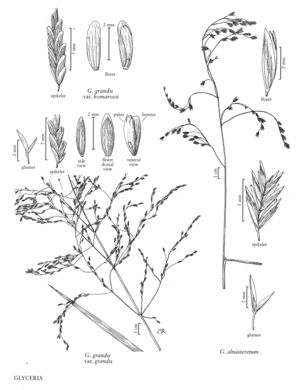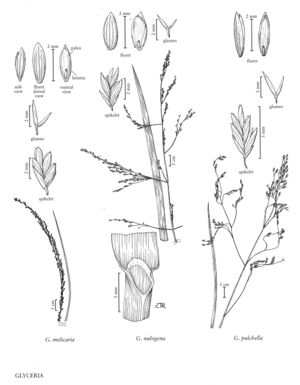Plants usually perennial, rarely annual; rhizomatous. Culms (10) 20-250 cm, erect or decumbent, freely rooting at the lower nodes, not cormous based. Sheaths closed for at least 3/4 their length, often almost entirely closed; ligules scarious, erose to lacerate; blades flat or folded. Inflorescences terminal, usually panicles, sometimes racemes in depauperate specimens, branches appressed to divergent or reflexed. Spikelets cylindrical and terete or oval and laterally compressed, with 2-16 florets, terminal floret in each spikelet sterile, reduced; disarticulation above the glumes, below the florets. Glumes much smaller than to equaling the adjacent lemmas, 1-veined, obtuse or acute, often erose; lower glumes 0.3-4.5 mm; upper glumes 0.6-7 mm; calluses glabrous; lemmas membranous to thinly coriaceous, rounded over the back, smooth or scabrous, glabrous or hairy, hairs to about 0.1 mm, 5-11-veined, veins usually evident, often prominent and ridged, not or scarcely converging distally, apical margins hyaline, sometimes with a purplish band below the hyaline portion, apices acute to rounded or truncate, entire, erose, or irregularly lobed, unawned; paleas from shorter than to longer than the lemmas, keeled, keels sometimes winged; lodicules thick, sometimes connate, not winged; anthers (1) 2-3; ovaries glabrous; styles 2-branched, branches divergent to recurved, plumose distally. x = 10.
Distribution
N.C., Conn., N.J., N.Y., Wash., W.Va., Del., D.C, Wis., Ariz., N.Mex., Pacific Islands (Hawaii), Mass., Maine, N.H., R.I., Vt., Fla., Wyo., Tex., La., Iowa, Minn., Oreg., Tenn., S.C., Pa., Ill., Ind., Md., Mich., Miss., Mont., N.Dak., Nebr., S.Dak., Utah, Okla., Calif., Nev., Va., Colo., Alta., B.C., Man., N.B., Nfld. and Labr., N.S., N.W.T., Ont., P.E.I., Que., Sask., Yukon, Ala., Kans., Ark., Ga., Idaho, Ohio, Mo., Alaska, Ky.
Discussion
Glyceria includes approximately 35 species, all of which grow in wet areas. All but five species are native to the Northern Hemisphere. The genus is represented in the Flora region by 13 native and 3 introduced species, as well as 3 named hybrids. One additional European species, G. notata, is included in this treatment because it has been reported to be present in the region.
All native species of Glyceria are palatable to livestock. They are rarely sufficiently abundant to be important forage species. Some grow in areas that are soon degraded by grazing. Glyceria maxima can cause cyanide poisoning in cattle. Species in sects. Striatae and Hydropoa have potential as ornamentals.
Glyceria resembles Puccinellia in the structure of its spikelets and its preference for wet habitats; it differs in its inability to tolerate highly alkaline soils, and its usually more flexuous panicle branches, closed leaf sheaths, and single-veined upper glumes. Some species are apt to be confused with Torreyochloa pallida, another species associated with wet habitats but one that, like Puccinellia, has open leaf sheaths. Glyceria includes several species that appear to intergrade. In some cases, the distinctions between such taxa are more evident in the field, particularly when they are sympatric. Recognition of such taxa at the specific level is merited unless it can be shown that all the distinctions between them are inherited as a group.
The three named North American hybrids are Glyceria xgatineauensis Bowden, G. xottawensis Bowden, and G. xoccidentalis (Piper) J.C. Nelson. The first two were named as hybrids; they are not included in the key and are mentioned only briefly in the descriptions. Glyceria xoccidentalis has hitherto been treated as a species. Studies finished shortly before completion of this volume indicate that it, too, consists of hybrids (Whipple et al. [in press]). It is included in the key and provided with a full description.
Culm thickness is measured near midlength of the basal internode; it does not include leaf sheaths. Unless otherwise stated, ligule measurements reflect both the basal and upper leaves. Ligules of the basal leaves are usually shorter than, but similar in shape and texture to, those of the upper leaves. The number of spikelets on a branch is counted on the longest primary branches, and includes all the spikelets on the secondary (and higher order) branches of the primary branch. Pedicel lengths are measured for lateral spikelets on a branch, not the terminal spikelet. Lemma characteristics are based on the lowest lemmas of most spikelets in a panicle. There is often, unfortunately, considerable variation within a panicle.
Selected References
Key
| 1 | Spikelets laterally compressed, lengths 1-4 times widths, oval in side view; paleal keels not winged (sects. Hydropoa and Striatae). | > 2 |
| 2 | Upper glumes 2.5-5 mm long, longer than wide. | > 3 |
| 3 | Blades 3-7 mm wide; culms 2.5-4 mm thick, 60-90 cm tall; anthers 0.7-1.2 mm long | Glyceria alnasteretum |
| 3 | Blades 6-20 mm wide; culms 6-12 mm thick, 60-250 cm tall; anthers (1)1.2-2 mm long | Glyceria maxima |
| 2 | Upper glumes 0.6-3.7 mm long, if longer than 3 mm, then shorter than wide. | > 3 |
| 4 | Panicles ovoid to linear; panicle branches appressed to strongly ascending; ligules of the upper leaves 0.5-0.9 mm long. | > 5 |
| 5 | Panicles 5-15 cm long, 2.5-6 cm wide, ovoid, erect | Glyceria obtusa |
| 5 | Panicles 15-25 cm long, 0.8-1.5 cm wide, linear, nodding | Glyceria melicaria |
| 4 | Panicles pyramidal; panicle branches strongly divergent or drooping; ligules of the upper leaves 1-7 mm long. | > 5 |
| 6 | Lemma apices almost flat; anthers 3; veins of 1 or both glumes in each spikelet usually extending to the apices | Glyceria grandis |
| 6 | Lemma apices prow-shaped; anthers 2; veins of both glumes terminating below the apices. | > 7 |
| 7 | Glumes tapering from below midlength to the narrowly acute (< 45°) apices; lemma lengths more than twice widths | Glyceria nubigena |
| 7 | Glumes narrowing from midlength or above to the acute (> 45°) or rounded apices; lemma lengths less than twice widths. 8. Spikelets (2.5)3-5 mm wide; lemma veins evident but not raised distally; palea lengths 1.5-1.8 times widths | Glyceria canadensis |
| 8 | Spikelets 1.2-2.9 mm wide; lemma veins distinctly raised throughout; palea lengths 1.5-3.5 times widths. | > 9 |
| 9 | Lemmas 2.5-3.5 mm long; glume lengths about 3 times widths, glume apices broadly acute; lower glumes 1.5-2 mm long; upper glumes 2-2.6 mm long | Glyceria pulchella |
| 9 | Lemmas 1.2-2.2 mm long; glume lengths up to twice widths, glume apices rounded or acute; lower glumes 0.5-1.5 mm long; upper glumes 0.6-1.5 mm long. | > 10 |
| 10 | Blades 2-6 mm wide; anthers 0.2-0.6 mm long; culms 1.5-3.5 mm thick | Glyceria striata |
| 10 | Blades 6-15 mm wide; anthers 0.5-0.8 mm long; culms 2.5-8 mm thick | Glyceria elata |
| 1 | Spikelets cylindrical and terete, except at anthesis when slightly laterally compressed, lengths more than 5 times widths, rectangular in side view; paleal keels usually winged distally (sect. Glyceria). | > 2 |
| 11 | Lemmas tapering from near midlength to the acuminate or narrowly acute apices; paleas exceeding the lemmas by 0.7-3 mm; palea apices often appearing bifid, the teeth 0.4-1 mm long | Glyceria acutiflora |
| 11 | Lemmas not tapered or tapering only in the distal 1/4, apices truncate, rounded, or acute; paleas shorter or to 1(1.5) mm longer than the lemmas; palea apices not or shortly bifid, the teeth to 0.5 mm long. | > 12 |
| 12 | Lemma apices with 1 strongly developed lobe on 1 or both sides, entire to crenulate between the lobes; blades 3-12 cm long; primary panicle branches 1.5-9.5 cm long | Glyceria declinata |
| 12 | Lemma apices not or more or less evenly lobed; blades 5-30 cm long; primary panicle branches 3-18 cm long. 13. Lemmas 5-8 mm long. | > 13 |
| 14 | Anthers 0.6-1.6 mm long; lemma apices usually slightly lobed or irregularly crenate | Glyceria xoccidentalis |
| 14 | Anthers 1.5-3 mm long; lemma apices usually entire | Glyceria fluitans |
| 13 | Lemmas 2.4-5 mm long. | > 14 |
| 15 | Lemmas usually smooth between the veins, if scabridulous the prickles between the veins smaller than those over the veins. | > 16 |
| 16 | Lemmas usually acute, sometimes obtuse, entire or almost so; adaxial surfaces of the midcauline blades usually densely papillose, glabrous | Glyceria borealis |
| 16 | Lemmas truncate to obtuse, crenate; adaxial surfaces of the midcauline blades rarely densely papillose, sometimes sparsely hairy. | > 17 |
| 17 | Culms 73-182 cm tall; pedicels 0.7-1.7 mm | Glyceria septentrionalis |
| 17 | Culms 25-80 cm tall; pedicels 1-6 mm | Glyceria notata |
| 15 | Lemmas scabridulous or hispidulous between the veins, the prickles between the veins similar in size to those over the veins. | > 16 |
| 18 | Lemma apices acute. | > 19 |
| 19 | Lemmas 2.4-4.8 mm long; pedicels 0.7-1.7 mm long; plants from east of the Rocky Mountains | Glyceria septentrionalis |
| 19 | Lemmas 4.5-5.9 mm long; pedicels 1.5-8 mm long; plants from west of the Rocky Mountains | Glyceria xoccidentalis |
| 18 | Lemma apices truncate to obtuse. | > 19 |
| 20 | Pedicels 0.7-1.7 mm long; anthers 0.5-1.8 mm long; plants from east of the Rocky Mountains | Glyceria septentrionalis |
| 20 | Pedicels 2-5 mm long; anthers 0.3-0.9 mm long; plants from British Columbia and the Pacific states | Glyceria leptostachya |
"decumbent" is not a number.


